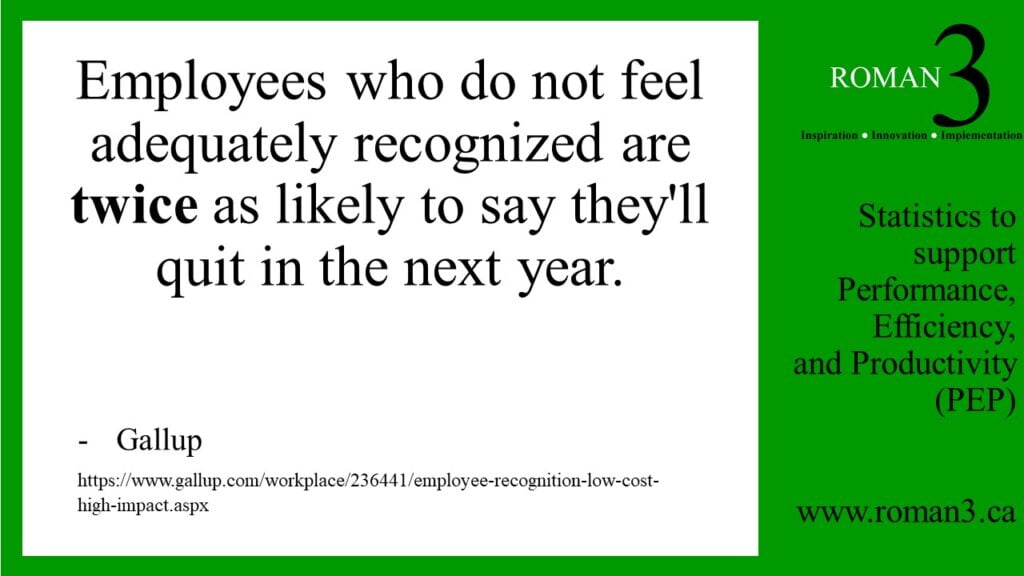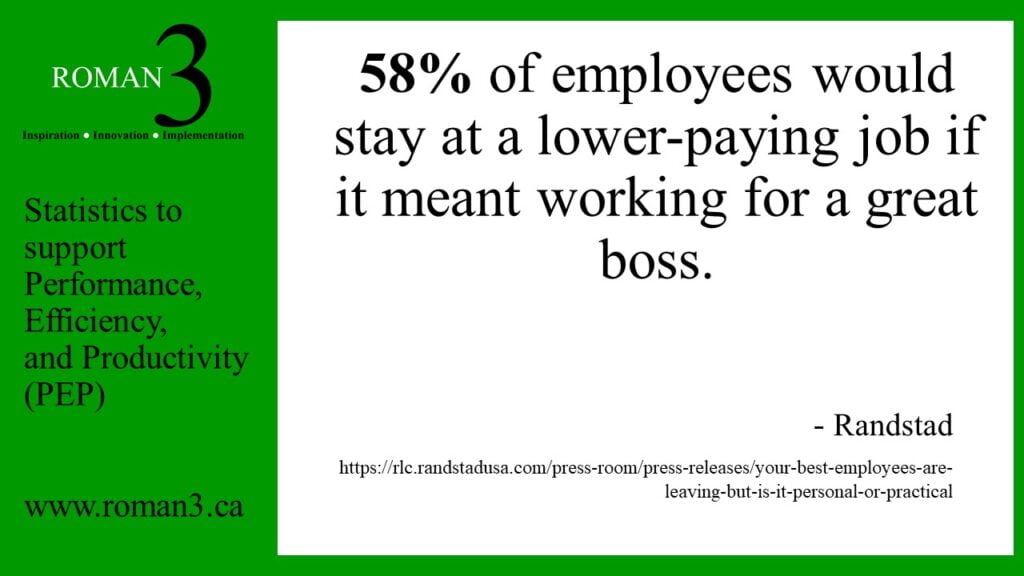- +1 902 932 7300
- Academy@roman3.ca
- Mon - Fri: 9:00am - 9:00pm
- 11 Opportunity Lane, Coldbrook Nova Scotia, Canada B4R 0A5
The 4 Pillars of Engagement

By Roman 3 Academy
Table of Contents
What are the 4 Pillars of Engagement?
The 4 Pillars of Engagement are the foundation of all employee engagement efforts. In our What is Employee Engagement? article, we discussed what employee engagement is, its effects on your bottom line, and introduced you to both The 4 Pillars of Engagement and the Workplace Culture Hierarchy.
In this article we will break down the 4 Pillars of Engagement and discuss each part in greater detail. So, what are the 4 Pillars of Engagement?
They are: Recognition, Autonomy, Mastery, and Purpose (or RAMP for short). Our goal with this article is to provide a foundation of information about each of these pillars that will allow you to begin effecting change in your workplace.
Recognition at Work

The first of the 4 Pillars of Engagement is Recognition. It is a fairly self-evident statement that people want to be appreciated and recognized for their efforts, so why do we so often miss the mark? Why does my team not respond when I try to give them praise? Why is there a disconnect between telling my team that they’ve done a good job and any increase in happiness or satisfaction?
To answer these questions (which have been posed to us by many clients) we have to understand that Recognition at Work cannot be an isolated effort, rather part of a consistent set of expectations and communication. So, what is Recognition at Work? The efforts that organizations make to provide appreciable, timely, and authentic acknowledgment of an employee’s behavior, effort, or results that supports the organization’s goals and values.
The key parts of this definition are the words appreciable, timely and authentic. Appreciable because if the way you show recognition does not resonate with the person receiving your efforts – the good you do may be lost or miscommunicated. It is important the recognition be timely in order to be relevant, but most importantly it needs to be authentic. Without authenticity it is not appreciation it is merely confirmation, you are acknowledging that something happened or took place.
If employees do not feel adequately recognized, they are twice as likely to say they’ll quit in the next year. No one wants to feel like they are not being valued, now more than ever people are willing to leave jobs to find somewhere or someone else who will appreciate them.
Relying on any one or two forms of recognition to the exclusion of the others will ultimately undermine your attempts to build recognition and appreciation at work.
The reality is, even when managers do try to recognize and appreciate staff, their efforts often fall short. This is because they make some far too common mistakes. We’ve outlined in detail what these problems are in this video. A quick summary is that we often do not communicate effectively, we show recognition to others based on how we prefer to receive recognition ourselves, and we rely too much on any one or two strategies to the exclusion of the others.
When we do think about recognition at work, it is often in terms of 3 things:
- Saying something nice
- Doing something nice
- Giving something nice
The truth is that there are 7 ways in which we can show Recognition at Work and in order to receive the full benefits of recognition and appreciation in your workplace you need to incorporate the SevenFold Recognition™ methods.
- Encouraging Feedback
- Meaningful Efforts
- Concrete Symbols
- Undivided Attention
- Personal Connections
- Professional Independence
- Skill Mastery
Many people will be familiar with Dr. Gary Chapman’s 5 Love Languages. There are many parallels between showing appreciation and love to those in our personal lives and how we need to show Recognition at Work. The Love Languages do not translate perfectly to the workplace, but the underlying psychological theories are similar. Which is why Roman 3’s Sevenfold Recognition™ methods are a perfect fit for the modern workplace.
Recognition is the first of 4 Pillars of Engagement and if you would like to learn more about Recognition at Work we have a 1h course you can take to learn more about Improving Recognition at Work.
Autonomy at Work
The second of the 4 Pillars of Engagement is Autonomy. If employees do not feel they have flexibility or freedom in their work, they will not be able to give you their best. But, flexibility and freedom are not just about being able to work from home or have more vacation time. It is about being trusted and supported to be as productive as possible.
Autonomy has become a popular topic of conversation, especially with the effects the pandemic has had on work-life balance. Author Daniel Pink in his book Drive: The Surprising Truth About What Motivates Us, touches on the topic of autonomy and the importance of being self-directed and work-life balance.
Autonomy at Work is more than just work-life balance or reducing employee oversight though. It is the efforts that organizations make to build trust and responsibility in employees, providing limited freedom in how they shape their work environment. The important aspects of our definition is to understand that we build trust through limited freedoms. Without trust, any efforts we make to provide more autonomy to our teams will be superficial at best and potentially more damaging than not in the long term.
When organizations begin to take steps to incorporate trust into their workplace, some amazing results can happen. Organizations that have committed to building a culture of trust, report that their employees are: 106% more energized at work, 76% more engaged, 50% more productive, 29% more satisfied, as well as being 74% less stressed, 40% less likely to burnout, and taking 13% fewer sick days. Something as simple as finding ways to incorporate more trust in the culture of the workplace can see dramatic improvements in virtually all areas of common labor complaints.
Without trust, any efforts we make to provide more autonomy to our teams will be superficial at best and potentially more damaging than not in the long term.
The data is clear, building a culture of trust will help our businesses. So, how do we build trust with our workforce? The answer to our question is right in the definition we use for Autonomy at Work: efforts that organizations make to build trust and responsibility in employees, providing limited freedom in how they shape their work environment.
Autonomy at Work is not simply about giving people the option to work from home, or weakening oversight. True Autonomy at Work is evaluating the rules and expectations of our workplace through the lens of The 6 Freedoms:
- Freedom of Judgement
- Freedom of Setting
- Freedom of Resources
- Freedom to Fail
- Freedom to Explore
- Freedom to Speak Up
These 6 Freedoms are essential to understand if you want to build Autonomy at Work. Greater Autonomy, and through Autonomy – greater trust, will create a work environment where people feel free to use their professional judgement, are free to work in a way they can be most productive, are free to use the resources they need to be successful, where they are free to try and equally free to fail, where they can explore opportunities to improve their jobs and have the freedom to speak up and advocate for themselves without fear of reprisal.
Improving Autonomy at Work is an excellent place to start if you want to learn more about how you can build trust and responsibility in your employees.
Mastery at Work
The third of our 4 Pillars of Engagement is Mastery. It is the idea that in order for someone to be fully engaged in their work, they need to be able to use and develop their skills. If we’re being honest, the majority of us can admit there have been times in our careers where we’ve felt bored and unchallenged by the work we were required to do. Boredom is a problem that’s a growing workplace trend and is seen as a psychological disorder that can lead to burnout and illness. Building Mastery at Work is how you can combat this problem.
We define Mastery at Work as the efforts that organizations make to support employees’ skills by; identifying and valuing them, using them effectively, and developing them for greater achievement. When employees feel that their employer values their future and makes tangible efforts to invest in their development, this allows the employee to see a future with the company. In fact, 94% of employees would stay in their current role longer if they felt the organization invested in their professional development. This is something that is becoming more and more important in the workplace as the labour market sees a generational shift.
94% of employees would stay in their current role longer if they felt the organization invested in their professional development. This is something that is becoming more and more important in the workplace as the labour market sees a generational shift.
When we try to incorporate the three components to mastery (Identify, Use, Develop), our biggest mistake is to think of them as separate processes, instead of one connected system. At best we will often pair two of them together, but when we only use two of the three it often creates the common problems with Mastery.
When we Identify and Use our skills, but do not Develop them:
We create complacent employees.
People have skills and use them, but do not expand or challenge their skill set. This is how we create people who have 1 year of experience 10 times, rather than 10 years of experience.
When we Use and Challenge our skills, but do not Identify them:
We create generic employees.
People have used and developed skills, but the skills do not take into account an employee’s past or talent. This is how we often try to make everyone the same, by providing broad generic training that is a mile wide and an inch deep.
When we Identify and Challenge our skills, but do not Use them:
We create unsupported employees.
People who have identified and developed skills, but do not get to use them are a common wasted expense at many businesses. This is when someone is trained to do something they show interest and aptitude for, but are not given the chance to apply what they have learned.
So how do we incorporate Mastery at Work?
If you want your employees to truly be better, and you want to successfully develop and use the skills of your people, then you need a framework to encourage your teams to be better not just busy. Our preferred framework is a strengths based approach using our 6 Roles of Mastery.
The Roles are models of the different functions in a team. When used collectively they allow people to focus their efforts on becoming very good at specific parts of the big picture, instead of expecting all people to be fairly good at everything. These Roles are the key to a framework that will help you value, use, and develop the skills of your team, while encouraging cooperation and better employee engagement. These 6 Roles through a strengths based framework are the catalyst for increasing team performance.
The 6 Roles are as follows:
Finders – They are hunters of the team who look forward to the chase and are results oriented. They will work very hard to gather what they are pursuing, but once they get it they want to pass it on to someone else so they can continue hunting.
Minders – They are administrators of the team who look to make sure everything is organized, and running smooth. They will work very hard to make sure everything goes according to the plan and everyone is prepared.
Grinders – They are the doers of the team who will do a lot of the creation and development of the work that the others need. They will work very hard to ensure that the quality of the work is met and will not want to be disturbed until it is.
Binders – They are the bridge builders of a team who look to make sure everyone has what they need and that there is harmony among the people. They will work very hard to make sure that the people are taken care of so they can do their best.
Pathfinders – They are the explorers of a team who look to make sure everyone is working at their best. They will work very hard to find new and better ways to improve how the team functions so they can achieve the best performance possible.
Spellbinders – They are the influencers of a team who look to make sure everyone is facing the right direction and on board with the plan. They will work very hard to communicate evidence-based and convincing reasons for the work to keep everyone on task.
If you make the effort to understand your team’s skills, put them in roles that play to those skills effectively, and push them to get better at what they are already good at, you will begin to create Mastery at Work. Learn how to do this effectively in our Improving Mastery at Work course.
Purpose at Work

The last of the 4 Pillars of Engagement is Purpose. How do you instill work with a sense of purpose? This is a question that many authors have written about and is the topic of importance for anyone seeking to tap into the motivations of their workforce.
In a study of 2000 workers, 90% said they would forgo 23% of their entire future lifetime earnings in order to have a job with meaning and purpose. The all-mighty dollar does not have the same influence as it once did, people are looking for fulfilment, and they are willing to sacrifice to get it. The sad reality is that most of them are not getting it. Less than 30% of workers, from, baristas to CEOs, feel their work is a way to gain fulfillment and help others. This is not just a problem at entry level jobs, this is a pervasive problem at all levels. But this is something that the workforce already knows.
When discussing Purpose at Work there are two excellent authors that are worth highlighting. Daniel Pink and Simon Sinek.
Both authors have written on the topic of Purpose and each takes a slightly different approach. Pink looks at Purpose from the perspective of clearly identify your Why and communicating it internally to your team as a form of motivation. Sinek looks at purpose from the perspective of identifying your Why and communicating it outward to your customers.
Both authors have excellent videos and books written on the topic of identifying your big picture ‘why’ and helping you communicate your ‘why’ to the audience of your choice. Unfortunately human motivation is not centered merely on one big picture ideal and this is where the theories of both authors fall short.
When discussing Purpose at Work we define it as the efforts that organizations make to align business outcomes with their employees’ internal sense of direction and meaning. If employees do not feel like they can’t find a sense of meaning and purpose in their job, then they will be less motivated.
All of us have a number of reasons why we are motivated to work. Often the big picture ‘Why’ is an excellent way to inspire motivation in others. At Roman 3 Operations, our ‘why’ is to provide transformative learning that creates lasting change in workplaces where people are appreciated, trusted, encouraged and inspired to be the best version of themselves. This is our aspirational statement. Our ‘Why’. And while it is what we try to live out every day, a big picture ‘Why’, no matter how inspirational, cannot sustain employee motivation long-term. For that, we need to look beyond the big picture, and examine The 8 Sparks of Purpose.
The sad reality is that most workers are not finding purpose in their work. Less than 30% of workers, from, baristas to CEOs, feel their work is a way to gain fulfillment and help others. This is not just a problem at entry level jobs, this is a pervasive problem at all levels.
The 8 Sparks of Purpose are as follows:
- The Spark to Provide
- The Spark to Accumulate
- The Spark to Be Part of Something
- The Spark of Loyal to Others
- The Spark to Achieve
- The Spark to Stay Relevant
- The Spark to Improve Yourself
- The Spark to Make a Difference
Its only by tapping these sparks of purpose that we can sustain motivation. If we fail to sustain motivation in our workforce, they will seek out other places where their sparks can be ignited. For some, that will mean looking for other employment, others will find their spark ignited through volunteer work or engagement in activities outside the workplace. While these things are not inherently bad, the key takeaway is to understand that the more you are able to align the work you do with the sparks of purpose your employees are searching for, the more motivated your employees will be to perform their best.
Want To Work With Us?
Book Your Free Consultation Today
You will receive a no obligation customized plan, tailored to meet your unique needs.

